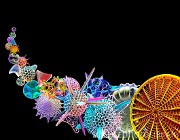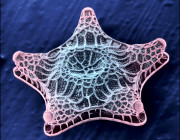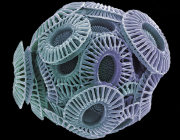Home :: List of Publicly Available Datasets :: Elphidium margaritaceum Unknown
Elphidium margaritaceum Unknown
Downloads:
| Principle Investigator(s) | Jan Pawlowski |
|---|---|
| External sample ID | 12EM |
| NCGR Sample ID | MMETSP1385 |
| Sample accession number | CAM_SMPL_003143 |
| Assembly accession number | CAM_ASM_000861 |
| Combined Assembly Name | N/A |
| Genus | Elphidium |
| Species | margaritaceum |
| Strain | Unknown |
| Clonal | No |
| Axenic | No |
| Prelim. NCBI Taxon ID | 933848 |
| 18S rRNA | |
| Importance of organism and transcriptomes | Foraminifera are among the most abundant and diverse marine protists, characterized by granuloreticulopodia. Their tests or shells are an important component of marine sediments and widely used as biostratigraphic markers. Elphidium margaritaceum is classified within the order Rotaliida. The genus is one of the most common in the coastal waters and our strain was collected from the English Channel. To date, the molecular data on this organism, and foraminifers in general, is poorly represented in the available databases. Our knowledge on the gene expression repertoire and metabolic pathways used by foraminifers is still very limited. Additionally, transcriptomic data has shown to be a powerful tool for finding orthologous genes for further phylogenetic analysis, in an aim to resolve the phylogenetic relationships among the group and within the Eukaryotes. |
| Additional citations and references | i. Pillet L, De Vargas C, Pawlowski J. Molecular identification of sequestered diatom chloroplasts and kleptoplastidy in Foraminifera. Protist 2011;162:394-404. |
| Environmental Data | |
| Primary citation for organism's characterization, if available | Elphidium advenum (Cushman) var. margaritaceum Cushman, 1930, The foraminifera of the Atlantic Ocean; Part 7 - Nonionidae, Comerinida, Peneroplidae, Alveolinellidae. U.S. Nat. Mus., Bull., Washington, D.C., USA. No. 104, p.25 |
| Sample collection site | English Channel |
| ENVO term for habitat - primary term | Acquatic: marine |
| ENVO term for habitat - secondary term | Sediment |
| Habitat | marine habitat |
| Country | FRANCE |
| Experimental Data | |
| Date of experiment | 06-DEC-12 |
| Growth medium | non cultivable |
| Temperature (ºC) | 18 |
| Salinty (psu) | 40 |
| pH | 8 |
| Day portion of day:night cycle in hours | 12 |
| Night portion of day:night cycle in hours | 12 |
| Nitrate (μmol/L) | 12 |
| Ammonium (μmol/L) | 4 |
| Phosphate (μmol/L) | 2 |
| Silicate (μmol/L) | 1 |
| Trace elements (total) (nmol/L) | 15 |
| Prey organism, if applicable (genus and species) | Bacteria and diatoms |
| Investigation type | Eukaryotes |








